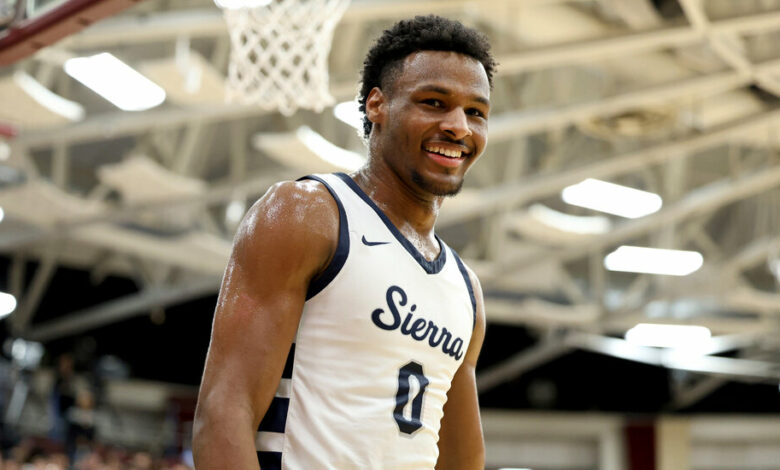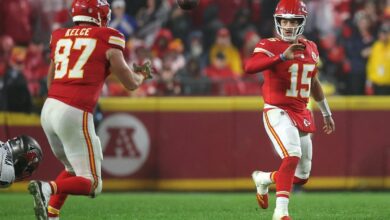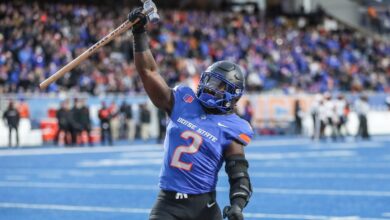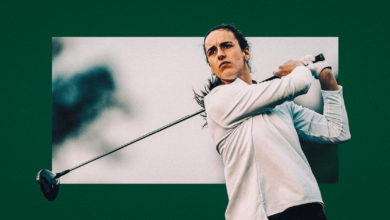Bronny James, son of LeBron James, is stable after cardiac arrest

LeBron James Jr., the son of NBA star LeBron James, suffered cardiac arrest Monday while training at the University of Southern California in Los Angeles and was taken to the hospital for intensive care treatment, according to a statement from a spokesperson for LeBron James and his wife Savannah. The younger James, known as Bronny, is now in stable condition and no longer in intensive care, the statement said.
“LeBron and Savannah would like to publicly express their deepest thanks and appreciation to the USC medical and athletic staff for their incredible work and dedication to the safety of their athletes,” the statement said.
The Los Angeles Fire Department responded to a call for medical assistance at 9:26 a.m. in the 3400 block of Figueroa Street in Los Angeles, the address of the university’s Galen Center athletic facility, a department spokeswoman said Tuesday. The department would not disclose who needed medical attention, citing federal policy.
Bronny James, 18, will be a freshman at USC this fall. He is the eldest of Lakers star LeBron James’ three children. Bronny James was a four-star recruit and chose USC over Oregon and Ohio State.
The USC men’s basketball program was scheduled to take a 10-day exhibition trip to Greece and Croatia starting August 5. a statement it published in May. It was not clear if the team would still make the trip or if James would go.
Cardiac arrest, when the heart stops, is different from a heart attack, which occurs when blood flow in an artery that feeds the heart is blocked. More than 300,000 people a year suffer cardiac arrest outside of a hospital.
The survival rate for those who suffer cardiac arrest and receive bystander cardiopulmonary resuscitation is fair 11.2 percent. For those who defibrillate immediately, the survival rate increases to 41 percent. It was not known what treatment James received.
Brain damage is likely if a person in cardiac arrest goes four to six minutes without CPR, and brain death occurs after ten minutes. Only 8 percent of cardiac arrest survivors have a good neurological prognosis. Most “have some degree of brain damage,” Monica Sales, a spokeswoman for the American Heart Association said in an interview in January.
USC has experience dealing with cardiac emergencies. While training at the Galen Center last summer, incoming freshman Vincent Iwuchukwu suffered cardiac arrest and was hospitalized. Iwuchukwu returned to play in 14 games for the Trojans last season.
Keyontae Johnson, a budding star at Florida, went into cardiac arrest during a game in 2020. He eventually recovered and resumed his career at Kansas State, where he played last season on a team that reached the round of 16 in the NCAA tournament. Johnson was selected by Oklahoma City in the second round of the NBA draft in June.
Few cardiac events have played out as publicly as Damar Hamlin’s collapse from cardiac arrest during a national football match last season. Hamlin, who is now trying to resume his career with the Buffalo Bills, posted a message show of support for James on Twitter: “My prayers are also for Bronny and the James family. You are there for you, just like you have been there for me throughout my entire process.”
Montrice Wright, the mother of Kijani Wright, a freshman forward for the Trojans, said she had not spoken to her son since James’ breakdown, but she hoped he and the other members of the team could keep their heads above water after the second incident in just over a year.
“The concern doesn’t go away when you see something like this,” she said. “These kids are doing so much to themselves; they’re not resting enough and it’s been hot.”
Researchers from the University of Washington conducted a study comprehensive analysis of cardiac arrests in NCAA sportsDr. Kimberly Harmon, the lead author at Washington’s Center for Sports Cardiology, said black male college basketball players are at a higher risk of sudden cardiac death than other groups of players.
The annual risk of sudden cardiac death among black Division I basketball players is one in 5,000. For white players, it’s one in 16,000. Dr. Harmon said she and her colleagues have not found an explanation for the discrepancy.
“We see it time and time again, not just with NCAA players, but with high school athletes,” she said.
James isn’t the only son of an NBA star who has had heart problems. Shareef O’Neal, one of Shaquille O’Neal’s sons and a friend of James, underwent open-heart surgery in 2018 when he was 18 after he was diagnosed with a congenital heart defect that affected the coronary artery.
Since then, O’Neal has documented his recovery social media while he has been working to get back to playing basketball. O’Neal had to learn to walk again and spent several months in rehabilitation, according to the newspaper American Heart Association.
In an interview on “Now For Later” podcast O’Neal said this week: “In 20 years, I just want to be known as that kid who fought back against something that changed his life and made his dreams come true.
“I honestly thought I would never play basketball again,” O’Neal said.
Basketball is often an afterthought on the USC campus, where football predominates. But that was expected to change this season, partly due to the presence of the younger James, who has 7.5 million followers on Instagram, and who would play home games within walking distance of the arena where his father stars for the Lakers.
The crowd was expected to follow James, just as it had since the summer before he entered high school. Fans were turned away from the gym doors during a large high school recruiting event to watch him play against others in his age group.
As he grew and his game developed, James was seen by college coaches as a complementary player with a high basketball IQ: a guard who was viewed as an asset, but not a star, on a team with Final Four– ambitions.
His recruitment, however, played out largely as a “don’t call us, we’ll call you” game — and he eventually made visits, but not to basketball powerhouses like Duke and Kentucky. Instead, he visited schools where he might have played sooner: Oregon, whose benefactor is Phil Knight, a founder of Nike, the shoe company with a strong connection to the elder James; Ohio State, the school LeBron said he would have attended if he’d been required to attend college before entering the NBA; and his school closer to home, USC.
The Trojans will also have DJ Rodman, a transfer from Washington State whose basketball-playing father, Dennis, was a pop culture sensation in the 1990s. But it is more than a team of basketball star scions.
USC should be in pretty good shape after adding one of the nation’s top freshmen, Isaiah Collier, a point guard from Marietta, Ga. He’ll team with Boogie Ellis, the Pac-12’s second-leading returning scorer; center Joshua Morgan, who led the conference in blocks last season; and forward Kobe Johnson, who is the conference’s leading returner in steals.
Iwuchukwu, a 7-foot-1 center, is also considered an NBA prospect.
After this season, Bronny James is set to be eligible for the NBA draft. LeBron James has often said he would like to play with his son on an NBA team, and he has even hinted that he wants to play with his youngest son, Bryce, 16, who attends Campbell Hall School in Los Angeles. LeBron and Savannah James’ daughter, Zhuri, is 8.
LeBron James, 38, led the Lakers to the Western Conference Finals last season, his 20th in the NBA. In February, he became the NBA’s all-time leading scorer, surpassing Kareem Abdul-Jabbar, who held the title for nearly 39 years.
Livia Albeck-Ripka, Adam Zagoria And Jesus Jimenez contributed report.




